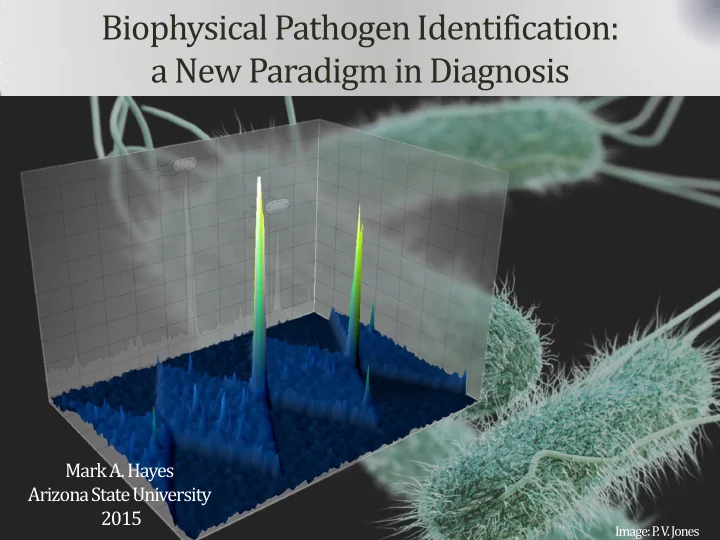

Biophysical Pathogen Identification: a New Paradigm in Diagnosis Mark A. Hayes Arizona State University 2015 Image: P . V . Jones
Early Pathogen Identification: Impact How do we correctly identify pathogens and their susceptibility early and accurately? …and gain this ‘wellness’? Wellness Why does it take so long now? Time What is the best way …to here to move this line from here…
An Ideal Pathogen Identification Scheme Pretty simple really: Fast : allow meaningful action Cheap : cost effective (<$1 per test) Available : widely distributed, low power use, simple operation and readout, etc. Accurate & Precise : sensitive and selective
Current Workflow of Pathogen Identification Time CORRECT Identification including susceptibility Susceptibility test Susceptibility test Phenotype Symptoms & Bias Loss Sample DNA/RNA Culture Culture/Metabolic Negative Vetting / Confirmatory No actionable result
Current Workflow of Pathogen Identification Time CORRECT Identification including susceptibility Susceptibility test Susceptibility test Lacking DNA/RNA sequence or Immuno Reagent for pathogen Phenotype Symptoms & Failure to thrive in Bias Loss Sample artificial environment DNA/RNA Culture Culture/Metabolic Negative Vetting / Confirmatory No actionable result
Current Workflow of Pathogen Identification Time CORRECT Identification including susceptibility Hyperfine Susceptibility test Susceptibility test Isolation Phenotype Symptoms & Bias Loss Sample DNA/RNA Culture Culture/Metabolic Negative Vetting / Confirmatory No actionable result
Current Workflow of Pathogen Identification Time CORRECT Identification including susceptibility Confirmatory / Vetting Hyperfine Susceptibility test Susceptibility test Isolation Phenotype Symptoms & Bias Loss Sample DNA/RNA Culture Culture/Metabolic Negative Vetting / Confirmatory No actionable result
Technology: How Does it Work? capture of E. coli surface plot Microfluidic device of simple design and fabrication. Juxtaposes two electric properties of cells & bioparticles: electrophoresis & dielectrophoresis It isolates and concentrates selectively with very high fidelity
Boat in a Specific Slip Analogy Each slip represents a unique strain and susceptibility There is a possibility of generating millions of biophysically unique ‘slips’ Thanks to Dr. Mclaren for analogy idea http://imgc.allpostersimages.com/images/P-473-488-90/67/6779/W21I100Z/posters/green-light-collection-aerial-view-of-a-harbor-lake-michigan-chicago- cook-county-illinois-usa.jpg
Stretching the Analogy Anything in the harbor : infection Specific slip: susceptibility Specific dock : species/strain Traditional techniques usually go: harbor, dock, slip. We can directly address the slip and then compare to known pathogens. Thanks to Dr. Mclaren for analogy idea : to his credit, he did not stretch it this far! http://imgc.allpostersimages.com/images/P-473-488-90/67/6779/W21I100Z/posters/green-light-collection-aerial-view-of-a-harbor-lake-michigan-chicago- cook-county-illinois-usa.jpg
Technology: How Does it Work? ( Con’t ) The reason our approach works is hyperfine resolution provided by the high electric fields and gradients afforded in a microdevice. 1 volt across 1 micron is 1 million volts per meter We operate with extremely intense fields and gradients to maximize the difference in forces on each strain of pathogen. Our calculations indicate that we can generate 10,000,000 unique addresses for pathogens.
How do we compare? : Specifics Desirable Features Aspects to be avoided or minimized • • Accurate and precise (sensitive Cold Chain Supplies & selective) • Costly reagents • Multiple Targets Simultaneously • Long analysis times • Sense unknown/undocumented • Bias • Simple operation • Expertise required • Fast • Inexpensive device and operation • Proven technology/strategy
How do we compare? : Global “Radar Plot” Our Strategy: Proven Good Time Multiple targets Less Good Culture negative Cost Prior molecular Costly reagents knowledge Many categories Unknown target Cold chain numerically plotted in easy to see plot. Many other categories could be imagined, these are reasonably representative.
How do we compare? : Global & current techniques Our Strategy: Current Techniques: Proven Proven Multiple Time Multiple targets Time targets Culture Cost Culture negative Cost negative Costly Prior Prior molecular reagents molecular… Costly reagents knowledge Unknown Cold chain target Unknown target Cold chain Culture / metabolic DNA/RNA Phenotype
Where are we now? We are in the technology development phase. Red blood cells, viruses, proteins, etc. have been evaluated and published. We have shown extraordinary proof of principle by separating Staphylococcus epidermidis gentamicin resistant and susceptible strains (one enzyme present/absent). Inlet Outlet • Gentamicin resistant, ATCC 35983 • Gentamicin sensitive, ATCC 14990 Our theory is completed and published (March 2015) and new high efficiency designs have been modeled and are being fabricated.
Economics • Minimal Cost • No specialized or cold chain reagents or highly constrained storage • Fabrication well-established • Inexpensive processes and materials • Power requirements are minimal (we use higher voltages, but current is minimal) • Packaging (optics, electronics, computing, etc.) are all compatible with the fast-evolving smart phone friendly systems • Final device and its operation will be compatible with wide distribution for possible surveillance, within all general practitioners, surgical theaters, and to low resource settings and remote areas.
Summary A new paradigm for identifying pathogens, including susceptibility Based on biophysics and a break-through technology advance in bioparticle separations Compares very favorably to current techniques: faster, cheaper, no bias, compatible with all existing strategies Early in the development cycle – core capabilities theoretical described, seminal data obtained. Looking to make maximum impact on healthcare – for specific patients, reduce disease spread, and reduce healthcare costs.
What’s Next? Continue to develop partnerships with those in the health care business. Identify and pursue funding sources for clinical application, while continuing fundamental studies at ASU.
Acknowledgements Katelyn Hayes Dr. Sarah Staton Paige Davis Dr. Michele Pysher Shannon Huey Dr. Ryan McLemore Claire Crowther Dr. Alex Mclaren Jie Ding Prof. Tom Taylor Paul Jones Prof. KP Chen Dr. Noah Weiss Funding: “Isolation of Pathogenic Listeria” NIH 2015 -2017 “Pathogen Isolation and Concentration for Phenotypic Subtyping” NIH 2012 -2014 “Isolating Viral Particles from Whole Blood” NIH 2012 -2014
End
Recommend
More recommend